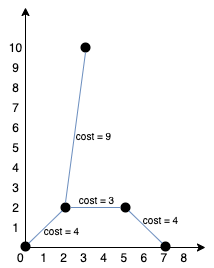问题描述
给你一个points 数组,表示 2D 平面上的一些点,其中 points[i] = [xi, yi] 。
连接点 [xi, yi] 和点 [xj, yj] 的费用为它们之间的 曼哈顿距离 :|xi - xj| + |yi - yj| ,其中 |val| 表示 val 的绝对值。
请你返回将所有点连接的最小总费用。只有任意两点之间 有且仅有 一条简单路径时,才认为所有点都已连接。

输入:points = [[0,0],[2,2],[3,10],[5,2],[7,0]] 输出:20 解释:

我们可以按照上图所示连接所有点得到最小总费用,总费用为 20 。 注意到任意两个点之间只有唯一一条路径互相到达。
示例 2:
输入:points = [[3,12],[-2,5],[-4,1]]
输出:18
示例 3:
输入:points = [[0,0],[1,1],[1,0],[-1,1]]
输出:4
示例 4:
输入:points = [[-1000000,-1000000],[1000000,1000000]]
输出:4000000
示例 5:
输入:points = [[0,0]]
输出:0
提示:
1 <= points.length <= 1000
-106 <= xi, yi <= 106
所有点 (xi, yi) 两两不同。
来源:力扣(LeetCode)
链接:https://leetcode-cn.com/problems/min-cost-to-connect-all-points
解答
/*prim算法,算法描述,请参考别人写的文章https://blog.csdn.net/qq_37241934/article/details/81133651 本题就是用prim算法构建一颗最小生成树。 */ class Solution { int n; public int minCostConnectPoints(int[][] points) { n = points.length; int[][] costs = new int[n][n];//记录costs[i][j]表示i到j的距离(开销)。 for(int i=0;i<n;i++){ for(int j=0;j<n;j++){ costs[i][j] = Math.abs(points[i][0]-points[j][0])+Math.abs(points[i][1]-points[j][1]); } } return minimumSpanningTree(costs, 0);//以0为起点,建立最小生成树。 } public int minimumSpanningTree(int[][] costs, int start){ int res = 0; int treeNode = 1;//节点数量, 初始树节点数量为1 int[] lowCosts = new int[n];//lowCosts[i]表示:节点i到生成树中的某个节点(比如最开始是到start)的最小权值(开销)。 int[] mts = new int[n];//mts[i]表示:距离节点i最近的一个生成树中的节点。 //下面要初始化这两个数组 for(int i=0;i<n;i++){ lowCosts[i] = costs[start][i]; mts[i] = i==start?-1:start;//mts[i]=-1表示i节点已经是生成树中的一员了。 } while(treeNode<n){ int newNode = -1; int min = Integer.MAX_VALUE; //下面寻找新的节点,将lowCosts中的最小值选出来作为新节点。 for(int i=0;i<n;i++){ if(mts[i]!=-1 && lowCosts[i]<min){ newNode = i; min = lowCosts[i]; } } //newNode!=-1表示找到了新的可以加入树的节点,那么找到了之后就要用newNode作为start,所以要更新两个数组。 if(newNode!=-1){ treeNode++; mts[newNode]=-1;//把newNode加入生成树 res+=min;//更新距离 //下面更新数组。 for(int i=0;i<n;i++){ if(mts[i]!=-1 && costs[newNode][i]<lowCosts[i]){ lowCosts[i] = costs[newNode][i]; mts[i] = newNode; } } } } return res; } }